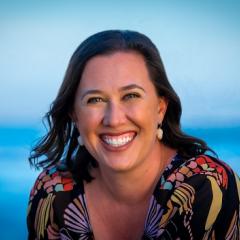Kristen Goodrich: Flood resilience in the U.S.-Mexico border region
How can we how can we learn from communities to understand risk and support resilience planning?
Kristen Goodrich brings a social ecological approach to characterizing natural hazards when developing flood modeling by studying the human experience with and response to flooding.
Before starting her PhD at UC Irvine in the School of Social Ecology, Goodrich began her work at NOAA’s Tijuana River National Estuarine Research Reserve, where she manages its coastal training program (CTP). CTP provides training and technical assistance for coastal decision-makers within the Southern California Bight, an area that spans from Santa Barbara to San Quintín, Mexico. One of the big topics she worked on was climate adaptation and resilience planning for the region, which led her to think about the how to improve environmental conditions while also improving human health, security, and quality of life within a socio-ecological system that is shared by both sides of the U.S.-Mexico border.
Sediment, trash and sewage threaten both environmental quality and flood resilience within communities adjacent to the Reserve on both sides of the border, says Goodrich. Flood control can fail due to sediment-laden and debris-blocked culverts and choke wetlands downstream.
To help promote resilience and promote cost effective solutions to the problem, a team of interdisciplinary researchers at UC Irvine were funded by the National Science Foundation to launch the FloodRISE project, for which Goodrich is a social scientist. FloodRISE uses advanced computer models to map flooding hazards on a detailed level. Flood risk information is made available to residents, city planners, emergency managers and natural resource managers, using a “menu” of maps that use understandable and relevant metrics based on the user. For example, in some maps, flood depth is depicted using the human body as a reference (e.g. ankle-, knee-, waist-, or head-deep).
Goodrich says that by not considering the lived and localized experience of a resident, for example, in designing technical solutions, the systems may not function or perform in a flood event as expected. One example that has stuck with her came from an interview she conducted where the subject remembered a major flood caused by a mattress blocking a culvert in Tijuana. Using this information, the engineers on the team were able to model a “100% blockage” of the canyon’s culverts to depict flood depth in this specific location, resulting in above-head water. Goodrich believes building models to reflect local conditions like this is critical to designing more adaptive flood control infrastructure and planning.
In addition to flood modeling, she says it is also critical to think creatively about how to build information systems that are accessible to residents, including those without computers. Preparedness training is key, says Goodrich, and she cites success the team has had with partnering with Proteccion Civil, an agency in Mexico, to develop a module on waste management to lessen the risk of debris exacerbating flooding in the vulnerable canyon communities of Tijuana where flood channels can become quickly overwhelmed.
As she winds up her dissertation research, she is working to apply what she has learned through this work to better understand pathways forward that seek multiple benefits for people and nature, especially in relation to natural hazards such as flooding in urban areas..
In the end, says Goodrich, “These disasters will happen. The more we can understand local conditions the more resilient our responses will be.
Publically accessible FloodRISE hazard viewers are available online at:
http://floodrise.uci.edu/online-flood-hazard-viewers/

